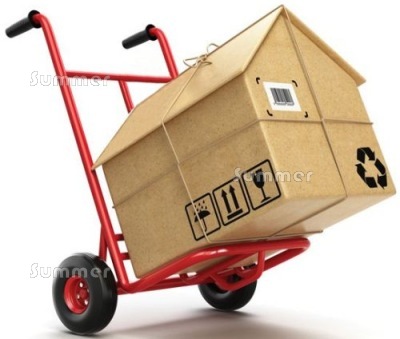Click this messge to hide it.
This useful guide contains information and advice about all aspects of your delivery. Please take a few minutes to read it. Also, please print it or save it on your computer for future reference. You should also have received our Important Product Information with comprehensive advice and useful tips to help you enjoy your purchase to the full. Please contact us if you have not received it.
CONTENTS
Scroll down or click on the links below:
- BOOK YOUR DELIVERY ONLINE
- YOUR DELIVERY - WITH A CRANE OR HAND OFFLOAD
- THE LORRY - WITH A CRANE
- CRANE OFFLOAD
- HAND OFFLOAD
- BOOKING IN THE DELIVERY
- RECEIVING YOUR DELIVERY
- STORING UNOPENED PACKS ON SITE
- ROADSIDE DELIVERY
- MOVING THE INDIVIDUAL COMPONENTS
- STORING INDIVIDUAL COMPONENTS ON SITE
- HELPFUL ADVICE
BOOK YOUR DELIVERY ONLINE
- You need to book your own delivery online at www.bookabldg.com.
- It is a simple process. Within 7 days after you order you will normally be contacted by email, text message or voice message to advise your unique Order Number. Without this number it is not possible to book your delivery.
- You will need your Order Number and the Delivery Postcode to access your account and book your delivery.
- Delivery to most areas is on the same day each week.
- You can select the next available day or a later day if you prefer.
- The software calculates when the lorry is full.
- Delivery is normally to the kerbside only.
- Somebody needs to be present to receive the goods and sign the delivery note.
- Although the load planning software is very accurate, occasionally there is a mismatch between the plan and the actual loading. In a small fraction of cases it may not be possible to load a building which may cause an unexpected last minute delay.
- We recommend that you arrange the installation only after the goods have been delivered and checked.
YOUR DELIVERY - WITH A CRANE OR HAND OFFLOAD
Your building will be unloaded quickly and easily either using a truck mounted crane or the driver will unload it by hand.
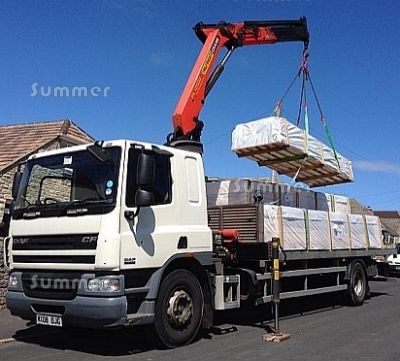
PICTURE: A truck mounted crane in use.
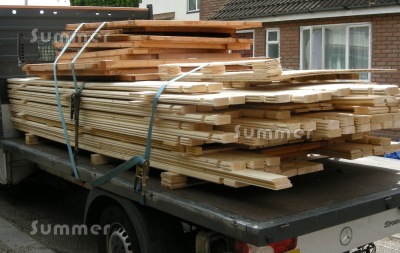
PICTURE: A smaller lorry with a cabin about to be unloaded by hand. The small shed on top is also part of the order.
THE LORRY - WITH A CRANE
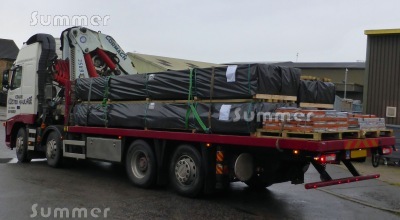
PICTURE: A lorry with a truck mounted crane, loaded with 4 log cabins and felt tiles.
- The delivery vehicle is a flat bed lorry with a truck mounted crane.
- The delivery vehicle is normally a rigid lorry around 10m (33ft) long.
- The lorry is approximately the same length as 2 cars parked in line, but please allow 3 car lengths for manoeuvering.
- The back of the lorry is normally around 8m (27ft) long.
- Reasonable access to your property and parking directly outside is assumed.
- Please advise if lorry access is difficult at your property.
- Please advise if there are any low bridges, narrow bridges, weight limits, width limits, parking restrictions, unloading restrictions or narrow lanes at or near your property.
- Our lorry is bigger than a large bin lorry. Please advise if a large bin lorry cannot easily park outside your property.
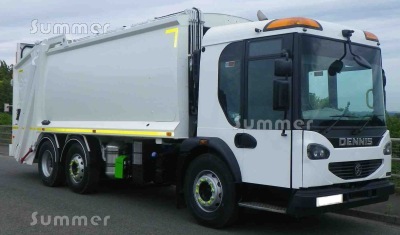
PICTURE: A large refuse lorry.
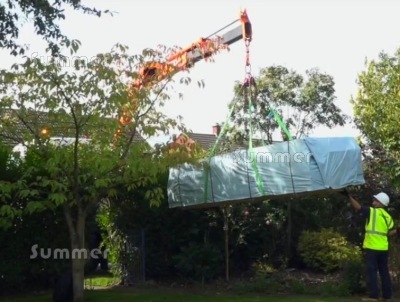
PICTURE: Lifting a cabin pack over a hedge into the back garden of a corner plot with a remote control crane.
CRANE OFFLOAD
- It is often possible to lift the pack over a wall, a fence or a hedge, for example at a corner plot.
- It saves a lot of time and effort if the pack can be placed near the site of the building.
- At most properties the pack is left on the drive, often along one side of the drive so it is out of the way.
- It is sometimes possible to leave the pack on the front lawn if there is a suitable area.
- It is normally possible to swing a pack around by 90 degrees to place it end on in the drive.
- Smaller packs can be moved further away from the lorry. The heaviest packs cannot always be moved very far.
- Stabilizer legs are extended from the lorry to keep the vehicle stable while the crane is in use.
- The arm of the crane normally requires height above it, which may restrict the options regarding where to place the pack.
- It may be difficult to move the pack far below overhanging trees or overhead cables.
- With the combination of trees and overhead cables it may be difficult to unload the pack in your preferred position.
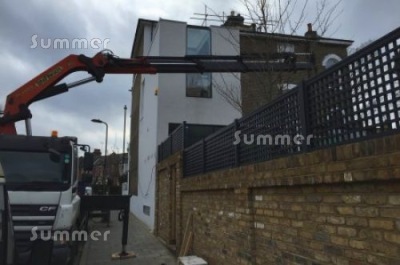
PICTURE: Lifting a pack over a garden wall into the back garden.
HAND OFFLOAD

PICTURE: The pack includes many individual boards and logs.
- If there is no lorry with a crane available, the driver will unload the components by hand, a piece at a time.
- The individual pieces of timber are mostly a mixture of wall logs and tongued and grooved floor and roof boards.
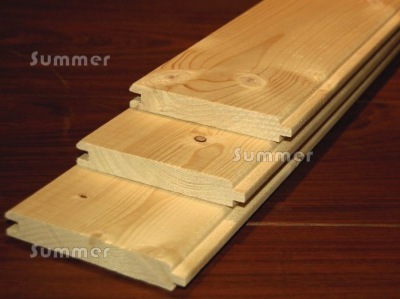
PICTURE: Tongued and grooved boards.
BOOKING IN THE DELIVERY
- You will receive advance notice of the delivery day either in writing or by telephone.
- If the date is not convenient you can normally postpone the delivery with reasonable notice. However, there may be a delay before the delivery team is in your area again.
- For security reasons, it is normally advisable for someone to be at home to accept delivery.
- The driver will unload your log cabin quickly and easily without assistance. The delivery lorry often includes a crane to unload your log cabin quickly. If there is no lorry with a crane available in your area the driver will unload the cabin by hand.
- The cabin is normally unloaded on the drive or on the verge at the front of your property.
- After the pack is opened the individual components are easy to carry. The wall logs can be carried one or two at a time and all packages are designed to pass through a normal single door.
- If your cabin is unloaded by hand the pack is opened and unloaded piece by piece so the loose components normally require moving again soon after delivery.
- If the pack is unloaded by crane we recommend not opening it until the installation work is just about to start, if possible, especially in warm weather or if warm weather is likely. This is because the original pack is tightly strapped and the timber cannot move.
RECEIVING YOUR DELIVERY
- If you expect somebody else to receive the delivery on your behalf, please email this guide to them or print a copy and give it to them.
- We recommend that somebody is present during the delivery in case decisions are needed about where to place the pack, for example, if your preferred storage position is not feasible.
- We recommend that somebody is present even if the delivery is straightforward. If nothing else, it ensures that the pack is delivered to the right property.
- If asked, we can request a call from the driver around 30 to 60 minutes before delivery. This ensures that even if you are out or at work you can still get home for the delivery. You can request a call from the driver when we phone to book in the delivery.
- Check the goods for any visible damage before signing the delivery note.
- If there is minor damage please do not refuse the delivery but add the word "damaged" next to your signature.
- There is always space on a delivery note or a hand held device to add a brief note.
- Any damage must be reported on the day of delivery. Please CLICK HERE to Contact Us.
- Please email a photograph of any damage to enquiries@summergardenbuildings.co.uk. This makes processing a claim faster.
- When signing for the goods, never use the words "unchecked" or "not checked", which are often interpreted as "received in good condition".
- Since the Covid-19 pandemic, there is often no requirement to physically sign for goods. However, you are still receiving a delivery whether you sign something or not. You should report any damage or suspected damage to the driver and ask to see evidence that your concerns have been noted. If you are not reassured please advise us promptly on the day of delivery.
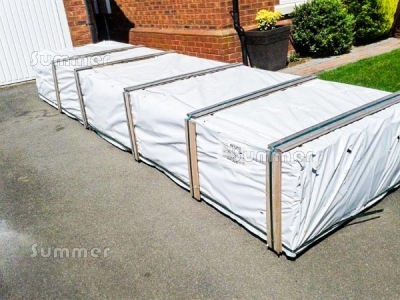
PICTURE: An unopened pack stored on one side of a drive.
YOUR PREFERRED STORAGE POSITION
- At most properties the pack is unloaded on the drive, often on one side of the drive so it is out of the way.
- It is sometimes possible to unload the pack on the front lawn if there is a suitable area.
- It saves time and effort if the pack can be unloaded near the site of the building.
- The unopened pack is covered on all sides with opaque polythene, which protects it from the elements and conceals the contents, so it can remain outside for a few weeks before installation.
- We recommend moving any loose components and portable accessories or roofing to a secure location as a precaution. The driver may be able help with this.
- We have delivered thousands of buildings in large packs and we have never heard of one being stolen from the front of a property. It would be difficult to steal without making a noise and it would take time. Nevertheless it is best not to store the building at the front for weeks.
- If you intend to store your building for a long time before assembly, we recommend that you store it behind a hedge or a wall if possible so it is hidden from view.
- We always recommend that you assemble your building without delay.
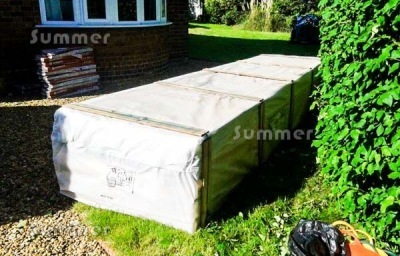
PICTURE: An unopened pack stored on a lawn.
STORING UNOPENED PACKS ON SITE
- If the pack is likely to remain outside for more than a few days we recommend that you inspect the cover carefully for any signs of a hole and patch it up with adhesive tape if required. Alternatively, cover it with a tarpaulin.
- If the pack is likely to remain outside for more than a few weeks we recommend covering it with a tarpaulin, which can be obtained from most DIY stores.
- In hot or sunny weather long pieces of timber can bow or twist and smaller pieces can shrink significantly, even if covered. This is less likely while the pack is tightly strapped but if possible store the pack in a shady spot.
- We do not advise leaving insulation anywhere which is visible to passers by, because it is valuable and lightweight.
- We do not advise leaving roof materials anywhere which is visible to passers by. Although heavier than insulation, it is equally valuable.
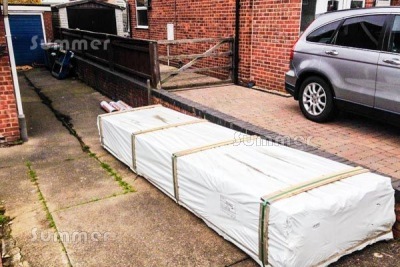
PICTURE: An unopened pack stored along one side of the drive.
ROADSIDE OR PAVEMENT DELIVERY
- When we phone to book in your delivery our expert adviser will look for possible problems at your address and discuss possible solutions with you.
- Although we all want your pack to be unloaded in the most convenient place at your address, unfortunately this is not always possible.
- The drivers are trained and experienced so they know the limits of their equipment best.
- The driver needs to unload the pack somewhere at or near your property and our large packs are often in the way at most sites to some extent.
- Occasionally, the only option available is an inconvenient place such as in the drive entrance blocking access for cars, or on the pavement or verge outside your property or on the side of the road outside.
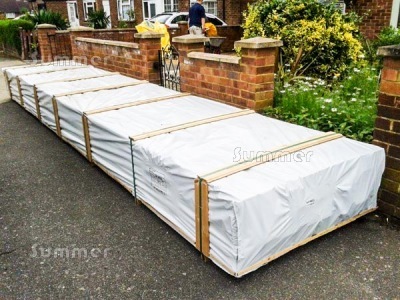
PICTURE: An unopened pack unloaded on the pavement.
- Unless you live in a no loading area or an urban clearway you are entitled to receive a pavement or roadside delivery.
- You are also entitled to a reasonable time in which to move the individual components from the kerbside after a delivery.
- If your pack is delivered on the road the best place is directly behind or in front of your car if it is legally parked. If possible you should leave your car there until after the individual components have been moved off the road.
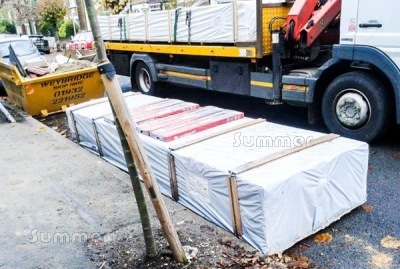
PICTURE: An unopened pack unloaded at the side of the road.
- A roadside delivery may need to be moved before nightfall to avoid causing a hazard.
- Most pavements are wider than our packs but even if our pack fills the width of the pavement, most roads have a pavement on both sides so pedestrian access is not obstructed.
- If the pack is in the way after unloading it may need to be moved quickly. For this we can only apologize. We try to avoid this if possible.
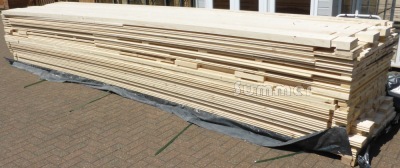
PICTURE: The inside of a full log cabin pack with the wrapping removed and the individual components exposed.
MOVING THE INDIVIDUAL COMPONENTS
At many sites you should not need to move the individual components until the installation starts. However, at some sites you may need to move the components soon after delivery, perhaps to make space in the drive or due to security concerns at an open fronted property. If you plan to assemble the building yourself, carrying the components into the back garden provides a good opportunity to familiarise yourself with the components.
- To open the pack normally requires a sharp knife. A claw hammer may also be required.
- You will need thick and tear resistant gloves. Always wear gloves when handling timber to avoid cuts and splinters.
- First cut the straps to open the pack.
- Some packs feature timber outer framing which needs to be carefully removed first.
- Any polythene covering should also be completely removed to expose the components.
- Most of the components are individual pieces of wood weighing 5-10kg which can be unpacked one or two pieces at a time.
- Even a 6"x2" (145x45mm) wall log 20' long (6m) only weighs around 18kg.
- We recommend 2 people to unload the largest items safely.
- The heaviest components are often the windows and doors.
- The glass is often factory fitted, which reduces damage but it means the doors and windows are heavy.
- Smaller windows and single doors are often supplied in one piece, assembled in the frame.
- Larger windows and double doors are often broken down into separate sashes or door leaves with the frame in separate pieces.
- Other heavy components include triangular front and rear gables supplied with apex roof cabins. Gables are often supplied in one piece for easier installation. Disposable battens which hold the gables together during handling are removed after installation.
- Other heavy components include prefabricated roof panels, which are sometimes supplied with corner cabins and smaller hexagonal or octagonal buildings.
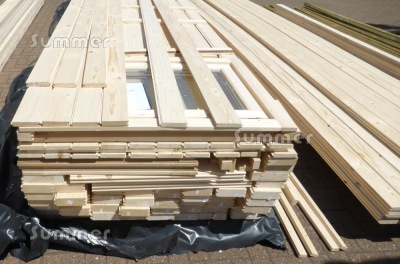
PICTURE: The log cabin pack pictured above after unpacking many of the individual components.
STORING THE INDIVIDUAL COMPONENTS
- If you move the individual components from the original delivery point but you do not start the installation work straightaway, you need to protect the components.
- You should stack the components neatly on the original pallet and strap the components tightly to the pallet to restrict any possible movement of the timber.
- We recommend using the original pallet at the bottom of the pack to store the components. It was tailor made for the job, providing a stable platform and preventing direct contact between the components and the ground.
- Be careful in hot or sunny weather to store timber components in a shady spot, if possible, or inside a garage or outbuilding. In strong sunlight long pieces of timber can bow or twist and smaller pieces can shrink significantly, even if covered. To counter this, you should tightly strap the timber to the pallet so that it cannot move.
- You can use DIY ratchet straps to strap the pack up tightly. These are inexpensive and widely available from DIY stores or online.
- If your order includes floor and roof insulation this can be also be placed on top of the pack. Insulation is the ideal material to protect timber components from strong sunlight.
- If you removed the original PVC covering in one piece it may be suitable for re-use. If not, a tarpaulin will help to keep the components dry.

PICTURE: 45mm thick double tongued and grooved wall logs.
HELPFUL ADVICE
This advice could be helpful whether you plan to install your building yourself or if you plan to have your building professionally installed:
- You should do what you can to ensure that delivery companies and installers do not make unproductive trips to the site. For example, if the base is still being built later than expected you may need to postpone the delivery or if the building is delivered late you may need to warn the fitter not to visit.
- The best time to discuss possible access restrictions is well in advance of delivery. The worst time is when a lorry is parked nearby, waiting to be unloaded.
- The company responsible for delivery assumes that there is good access at your property and normally asks you to confirm this, so if it is not possible to complete your delivery at the first attempt you may be liable to pay for a second delivery. You should not allow the delivery to proceed unless it can be successfully completed.
- Any installer normally assumes a clear site with ample working space and good access from the point of delivery with no restrictions, so if it is not possible to carry out the installation at the first attempt you may be liable to pay for a second visit. You should not allow the installer to visit unless the work can be successfully completed.
- Some delivery companies and installers choose not to carry long or heavy components through the house, due to the risk of damage to the product or your property.
- Most delivery companies and installers choose not to lift long or heavy components over obstructions such as a wall, a fence or a garage roof, due to the risk of product damage or personal injury.
- If you need any long or heavy components to be carried through the house or lifted over an obstruction, we recommend discussing it when the delivery is booked in and with your installer if this work is arranged separately. If there is no other option you may need to carry those components yourself or find somebody who can help.
- Our expert advisers can help you with advice so please contact us with any queries.
THANK YOU FOR SHOPPING WITH SUMMER GARDEN BUILDINGS
We produced these guidance notes in order to inform and reassure our customers, with detailed advice about many aspects of the delivery. However, despite our best efforts to provide comprehensive and accurate information and to update the details as required it is not always possible to describe in advance every situation which may arise. We apologise if your specific circumstances or queries are not adequately covered. All timescales are approximate and any procedures described may be subject to change. Please contact us if you have any queries.
